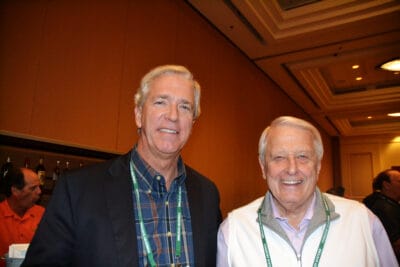Asked to assess their ups and downs in 2021, many Hardwood lumber company representatives said it was a successful year. Looking forward to 2022, their sentiment leans in the same direction. One respondent stated, “2022 should be a reasonably good year, albeit with some downward changes in prices more likely than continued upward.” Another said that in 2021, “demand trends” were created that “will likely sustain, prosperous times for the forest products industry into next year.” Still another lumberman said without qualification that he expects “a successful 2022.”

Eric Porter
Abenaki Timber Corp.
Kingston, NH
2021 has been a successful year for us, although not without some challenges. Labor issues have plagued both of our production facilities in New Hampshire and West Virginia. We have been about five people short of full staff at both locations all year, and a lot of the regulars are not putting in a full 40-hour shift.
Transportation is the No. 2 biggest problem, and that has been in both exporting with container shortages and domestic with lack of equipment to move loads. Thirdly is the green supply line which, for us, has been tight all year. I see these as the biggest challenges moving into 2022.
We sell to both domestic and international customers. Our domestic business has improved this year, and up until recently our exports have done well, too. Lack of available vessels has dampened the export market as of late.
Quality, consistency and service are the three things we try to provide each and every time we make a sale, and that’s not new. We are expanding our European Beech imports in more sizes and grades.
We installed a new gas-fired boiler at our West Virginia plant, replacing the old one to be more efficient in our drying there. We are also in the process of putting up some T-Sheds to improve our air-drying and the appearance of our lumber.
As stated previously, transportation is a real problem, and, from what I’ve heard, it is the same basically for all of our trading partners and competitors. The politics of actually working for a living here in the U.S. are not favorable for a quick solution, in my humble opinion.
At this time, I think that the issue of tariffs is secondary to the transportation and supply line issues.
With the disruption in supply chains due to COVID-19, our maintenance people at both of our concentration yards are buying extra parts to put on the shelf when available.

David Whitten
Bingaman & Son Lumber, Inc.
Kreamer, PA
In 2021, Bingaman Export was successful in staying ahead of the unprecedented demand for our products, as were most of our customers. We were unsuccessful in increasing production and strengthening our logistics channels.
Our end user customers fared the best, but distribution customers also did well. All White Oak and Tulipwood Poplar products shined.
Also this year, we connected our customers to logistics websites that gave them shipping lines info in direct/real time.
We have replaced and updated worn-out equipment in almost every area of our company at all five Pennsylvania locations, from replacing/updating sawmill equipment such as resaw, carriage and trim saws, to adding new boilers for KD steam, new kilns and new rolling equipment.
Domestic obstacles were finding long distance trucking, and then working out higher costs with our customers. Export-wise, transportation was a nightmare at times, as bookings were canceled or rolled oftentimes overnight after we had picked up and loaded the empty containers. This situation has not improved – but we are coping with it better now.
Regarding tariffs, the current and future concern is the dramatic effects of the Chinese government policies that gut real estate values, cut private company ownership by starving access to capital and reduce to half the raw material imports and manufacturer’s ability to produce by limiting electricity consumption.
As for the bandsaw shortage, we’ve found ways to cope.
In terms of the supply chain disruption due to COVID-19, we’ve made strategic moves in various ways to cope.
2022 should be a reasonably good year, albeit with some downward changes in prices more likely than continued upward. Domestic US/Canada demand should remain strong as well as UK/EU and some other first-world smaller countries. China could be quite unstable in 2022 as it’s a political year for the central committee, and a tipping point if their policies of recent years will continue stronger or somewhat abate. Our China wood customers’ demand is less for domestic consumption and more for export of finished product (back to the US, UK, EU) than has existed for many years. China domestic consumption of wood products is following the strong decline of real estate values.

Bo Hammond
Collins
Portland, OR
As lumber folks, we are either inherently gifted or quickly adopt industry practices of finding a way to negate any positive. Quite often, our perspective of good or bad depends on which side of the transaction we find ourselves. With that in mind, looking at 2021, I could certainly lament finding adequate labor, cry over trucking woes and port delays, or wish that I hadn’t committed to a particular price when I did; but the reality is that pricing for our products reached some historic levels and demand trends were created from an unexpected catalyst that created, and will likely sustain, prosperous times for the forest products industry into next year.
2021 saw a growth in domestic demand from manufacturers and distributors for our company and a reduction in overseas business. China, in particular, has been a dominant player in Hardwoods for the past decade, and the ability to turn our sales focus toward domestic demand was refreshing and honestly a positive development for our brand and ongoing sales strategy. As much as lumber supply was strained and we sometimes found ourselves having to delay fulfillment of orders, we were able to strengthen the relationships we have with key customers in all segments of our customer base from industrial grade buyers to cutting grade component manufacturers to high-grade buying distributors. At a time when trade issues seem to always be looming on the horizon, diversifying our sales reach domestically and to alternative global markets will be a benefit going forward.
Unfortunately, the Hardwood space has been shrinking now for over a decade. Of course, we rebound from catastrophic supply corrections like occurred after the great recession and most recently in 2020, but we have not been recovering all that we lost during those past cycles. I wish the Hardwood space had enough room for everyone that wanted to participate in it. If it did, then that would mean demand for – and understanding of – the products we make was ingrained in consumers’ minds. Unfortunately, that isn’t where we are, yet.
I am a firm believer that things happen for a reason and in the properly anointed timeframe. I also believe that we must recognize this and act to capitalize on the opportunities we are presented with…turn lemons into lemonade, find the silver lining in the clouds. The COVID pandemic was a catastrophic event, and I am not going to try to make the event itself into a positive. But the catalyst it provided to our industry, and what influences our industry’s health, are undeniable. Prior to COVID, the demise of McMansions had shifted home buying toward smaller spaces. New generations, not so quick to start families, were more content to rent within walking distance of work and daily needs. The shutdown and need for isolation created during the height of the pandemic and persisting through the onset of COVID variants, reversed those housing trends by creating a need for more designated spaces in a home and a desire/ability to live more rurally and still work where you want. This alone didn’t create a lack of adequate housing, but it accelerated the timeframe to correct it. Government subsidies, agreed with or not, kept households whole financially, sparking consumer spending. Our products have never faced a better time to be valued for what they are actually worth than right now.
Consumers with cash in hand and a reason to make new-home or remodeling decisions are abundant right now. The industry finally has a promotional campaign started that can educate the general consumer about why wood, real wood, is a better choice than fake wood or other alternative materials. We have an opportunity to start controlling our own destiny instead of playing the victim of our circumstances. Even though we may be shrinking as an industry right now, our key demand driving segment, housing related products, is growing and should for another year at least.
Without being a master economist, even a shrinking product line in a growing customer segment gets a boost. And perhaps this boost coincides with a promotional campaign that extolls the real value in Hardwood products and allows comfortable growth.
I am not naïve; current lumber prices, as of when I am writing this in early October 2021, will not all hold. But it is not naïve to understand that we have a product that adds value to a home and has environmental benefits that far outweigh competitive products. That is a value we as an industry need to sell and charge for. We are approaching 2022 with hope and optimism. I believe 2022 is unlikely to repeat the record setting prices of 2021; but I don’t believe the fundamentals of demand are collapsing either. Manufacturing will start the year still trying to catch up from the curtailments of 2021. Eventually, manufacturing will achieve that and growth in manufacturing will stabilize. Pushback on packaging prices will occur and pallet lumber prices will adjust, but the reality of packaging as an important, not just necessary, part of a manufacturer’s needs will keep dimension pallet lumber prices above prior levels. Housing will take longer to catch up, and remodeling will continue to be strong as unemployment remains low and household income remains reliable. Increased lumber production will come online but at a pace for only 7.5-8BBf annually, about 10-15 percent below the 2019-early 2020 level. Supply will maintain a better balance with demand but will not surpass it next year, allowing peak prices to ease but maintaining some gains in grade lumber. Flooring lumber will likely adjust more in line with industrial grades, but cabinetry, furniture, and millwork will still have strong demand, retaining some of the price gains for No. 1 and Better lumber.
Specifically at Collins, we continue to invest in manufacturing efficiencies at our Kane, PA plant. We installed a 38-bin sorter/stacker in late 2020 that has been helpful in navigating labor issues this year. We rebuilt the debarker this year to improve the quality of our edging and the infeed flow to the mill. We rebuilt several air-dry yards and redesigned our stacker outfeed to allow for more ideal weight distribution in our sticker packs to keep our lumber flat as possible. We are entertaining an upgrade to our kilns to improve efficiency and effectiveness and we are paving several of our roadways which will help with flow issues on our yard, and keep our sticker and finished goods bundles better packaged for better quality lumber and better presentation. Collins is a land-owning company that believes in the environmental benefit of not only owning timberland but also properly managing the harvest of our timberland to generate environmentally friendly raw material for manufacturing household goods. We value the customer relationships we have and approach our responsibility to honor their trust in us by producing the highest quality lumber responsibly with good width distribution, on grade and as on-time as possible. Relationships, consistency and reliability have always been stalwarts of the Hardwood industry, but never more so than now.
Best of Luck in 2022!

Dana Lee Cole
Hardwood Federation
Washington, D.C.
The Hardwood Federation works on your behalf in Washington, D.C. to protect the future of the Hardwood industry. We are the united voice of the Hardwood industry and work to influence federal policies that maintain a healthy economic environment for the Hardwood community, including family businesses and small companies.
The Biden administration set an ambitious agenda early in 2021…one that is sure to carry over into 2022. There are certainly opportunities for the Hardwood sector to benefit from some of their plans, but there are also some proposals that are cause for concern. While it is difficult to predict exactly what form that agenda items will eventually take, in terms of legislation, there are key policy directions that Hardwood Federation will pursue on behalf of the industry in 2022.
Recognize the important role forest products play in reducing atmospheric carbon: The Administration recognizes that the trees in our public and private forest lands absorb and store significant amounts of carbon. But it is equally important for them to acknowledge that the products resulting from well managed forests are 50 percent stored carbon by weight and that well managed, working forests are more effective and efficient carbon sinks than those that remain untouched. The Hardwood Federation will continue our efforts to ensure that the wood products market is not left behind in the Administration’s plans.
Prevent tax increases that harm small and medium sized businesses: Congress is considering a number of tax increases in 2021 and those deliberations could carry over into the new year. The Federation will oppose tax reform measures that have negative impacts on Hardwood businesses.
Support efforts to increase labor pool: Lack of workers is a top issue of concern for the industry. The Hardwood Federation is advocating for action that encourages workers to rejoin the workforce.
Back infrastructure proposals that help the Hardwood industry: The Hardwood Federation supports infrastructure and transportation legislative initiatives that help our companies transport raw materials, manufacture goods and ship finished products (better roads, safe bridges, better access to international shipping, reliable energy sources, etc.). We also advocate for proposals to increase the number of truck drivers, including increasing the number of younger drivers and women drivers.
While these are the Federation’s priority issues, we will also speak out on other issues that impact Hardwood companies as they come up. As a leader in the Hardwood industry, we encourage you to do the same. Meet with your Member of Congress, invite them to visit you and your employees at your facility, call, text or write to them about what is impeding your ability to sustain and grow your business. We are here to help! Write to us at hardwoodfederation@hardwoodfederation.com if we can provide guidance and advice.

Rob Paradise
Devereaux Sawmill
Pewamo, MI
21 has been a successful year, with crazy-good demand in the first half of 2021. It will be hard to match in 2022, but I anticipate a successful 2022 as well.
Our customers – distributors, cabinetmakers, flooring manufacturers and furniture crafters – all have had strong years.
Availability of transportation has been tough, and rising prices have been challenging.
With COVID-19, we have just tried to stay ahead on parts for our sawmill and order further out.

Bucky Pescaglia
MO PAC Lumber Co.
Fayette, MO
2021 was a record sales year for our company. We had a good-sized inventory to work from at the beginning of 2021, but it has been reduced to a historic low for most of the second half of the year. It will be difficult to repeat these sales volumes in 2022 as we simply do not have the same inventory to work from.
Although we have several large end-user customers, the majority of both international and domestic sales are to distribution yards. As with most in the Hardwood business in 2021, all of our products have experienced a strong and consistent demand throughout the year.
As I write this forecast, we are installing a new Corley carriage, Tyrone-Corley shotgun drive, and Lewis Controls Optimization to upgrade our sawmill. This will increase production and improve yield for our mill.
We are experiencing the same transportation issues everyone I talk to is. Congestion at the ports and on the rail, and lack of available trucks, result in delayed shipments and frustrated customers.
So far, it appears that the China tariffs return has been postponed for now. This should help stabilize the market.
We always try to stay far ahead of any possible bandsaw shortage by having a good supply in our warehouse. When we heard there could be shortages, we doubled our normal order and have been able to avoid any problems.
Regarding COVID-19 supply chain disruptions, we installed a new maintenance program this year, and it has been very helpful in keeping our parts inventory stocked.

Mario Lussier
Simon Lussier Ltée
Blainville, QC, Canada
At the beginning of 2021, we had no real idea what to expect. We knew that green lumber was difficult to source and that the prices were going up quickly. Many times, after purchasing significant volumes at high prices, we would wonder if we made a mistake and misjudged the market. We anticipated that mills might overproduce the demand and flood the market as we have seen so many times in the past.
Now that 2021 is coming to an end, we wished that we had purchased a lot more lumber in the early months of 2021 because prices have not stopped rising.
COVID-19 has had a big affect on our industry. Many mills cut down production in March 2020 and have not been able to recover since. Many people have left the industry and are not coming back. Many loggers are having problems finding a market for pulpwood, which is reducing the availability of saw logs.
Our level of sales in 2021 has been very strong in both the domestic market and the export market. We have been in a shortage situation on a multitude of items and could have increased our sales to a much higher level.
We anticipate another very good year in 2022. We think many items have probably reached their peak prices because we are seeing more and more substitutions with Eastern European species or African Hardwoods. It should be some time before we see significant drops in prices in North American species, because many wholesalers and distributors like us are very low in inventory and it should take a long time before we fill up.

Michael Martin
National Wood Flooring Association
Chesterfield, MO
The National Wood Flooring Association (NWFA) just completed our annual outlook for the wood flooring industry which indicated that 61 percent of our members expect to finish 2021 with an increase of 3-7 percent by year end. And, likewise, about 60 percent expect to be up in 2022. These answers varied by type of company. Contractors are very enthusiastic about 2022 as most report being booked out up to four months in advance for jobs. Distributors and manufacturers are likewise enthusiastic, but at slightly lesser levels.
The NWFA represents the entire wood flooring supply chain. Regardless of the type of member—manufacturer, distributor, retailer or contractor—the trend continues to be longer and wider when it comes to wood flooring. We are also finally seeing the gray tones lose popularity with natural wood tones coming into design trends. In addition, natural wood characteristics are preferred (mineral streaks, knots, etc.), but in a subdued way, which cannot be duplicated with look-alike products.
As an association, we continued to bring new online training options to our members in 2021. Usage of our online university has more than doubled during the COVID-19 era. From the product standpoint, our members report high demand for both engineered and solid wood flooring. In fact, solid wood flooring had the best year it has had since 2005, with an increase of nearly 40 percent coming in 2021 over last year. 2021 was the best year for solid strip flooring in more than a decade, with expectations high for 2022.
Many NWFA members report making building and equipment upgrades during the pandemic shutdown and the early days of the economy opening back up. However, once things got rolling, our industry couldn’t produce or install wood floors fast enough and those upgrades were postponed for the moment.
Freight costs on imports and exports have skyrocketed with no end in sight for 2021. Most expect container availability to loosen up by the second quarter of 2022, but from trucks to planes to trains to slow boats from China, every possible point of the supply chain is backed up with inflated costs.
Right now, expectations are that the current tariffs on imported engineered wood flooring will remain unchanged in 2022. That said, several manufacturers of engineered wood flooring have moved production from China to Vietnam to avoid tariffs, so it is hard to say whether we will see similar tariffs from additional countries.









